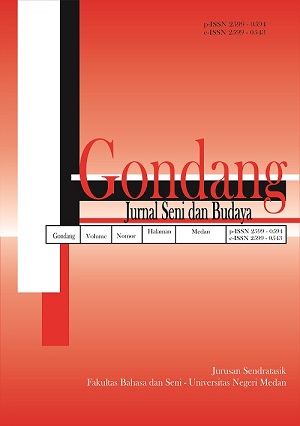Peningkatan Apresiasi Tari Nusantara Melalui Model Blended Learning di Sekolah Menengah Pertama
DOI:
https://doi.org/10.24114/gondang.v5i1.19323Keywords:
Nusantara Dance Appreciation, Blended Learning Model.Abstract
This research is aimed to improve knowledge, attitude, skill and appreciation of Nusantara Dances. It is conducted by Action Research method which is developed by Kemmis & McTaggart. The data were collected by questionnaire and analysed by Mix method which is developed by Creswell. The sample of this research is the 8th grade students of Public Junior High School 2 Kotabaru. Knowledge, attitude and skill of appreciation of Nusantara dances is important to be delivered to junior high school student as one of provision effort to nusantara culture, especially dances. The Learning of Nusantara Dances Appreciation is implemented through two cycles. Each cycle has four meetings. Before the intervention action of first cycle, there is a Pre-test. And then the final post test result of first Cycle shows that there is improvement result compared to the pre-test result. More over the post test result of second cycle is imporoved too compared to the post test result of the first cycle, even it has reached the set out target. In conclusion according to the result of the research, Blended learning model is effective to be used on improving the appreciation of Nusantara Dances. Thus, Art & Culture Teacher at school is suggested to use this blended learning model.References
Abdurahman, M. Sambas, A.M, Ating S. (2013). Dasar-Dasar Metode Statistika Untuk Penelitian. Bandung: Pustaka Setia
Creswell, J.W. (2016) Research Design: Pendekatan Metode Kaulitatif, Kuantitatif, dan Campuran, terjemahan Achmad Fawaid dan Rianayati Kusmini Pancawati, Yogyakarta, Pustaka Pelajar.
Dibia, I.W., Widaryanto, FX. &, Suanda, E. (2006). Tari Komunal. Jakarta: Lembaga Pendidikan Seni Nusantara.
Dimyati dan Mudjiono. (2006). Belajar dan Pembelajaran. Jakarta: PT Rineke Cipta
Hamalik, O (2007) Pengem-bangan Kurikulum, Jakarta, Bumi Aksara.
Hughes, A.G., dan E.H. Hughes (2012) Learning dan Teaching: Pengantar Psikologi Pembe-lajaran Modern, terjemahan SPA Teamwork Yogyakarta, Bandung, Nuansa.
Joyce, M., (1994) First Step in Teaching Creative Dance to Children, California, Mayfield Publishing Company.
Mahfud, S.S., (2009), Pendidikan Kewarganegaraan 2 Kelas 2 Jakarta: CV. GEma Ilmu
Mahmud, C., (2009) Pendidikan Multikultural, Yogyakarta, Pustaka Pelajar.
Majid, A., (2014) Pembelajaran Tematik Terpadu, Bandung, Remaja Rosdakarya.
Maloy, R, Ruth-Ellen Verock-O™Loughlin, Sharon Edwards, dan Beverly Woolf (2017) Transforming Learning with New Technologies, Boston, Pearson.
Masnur, M., (2007) KTSP Pembelajaran Berbasis Kompetensi dan Kontekstual, Jakarta, Bumi Aksara.
Masunah, J., dan Narawati, T., (2003) Seni dan Pendidikan Seni, Bandung, Pusat Penelitian dan Pengembangan Seni Tradisonal UPI.
Metler, C.A. (2014) Penelitian Tindakan Kelas: Meningkatkan Sekolah dan Memberdayakan Pendidik, terjemahan Benyamin Molon, Jakarta, Indeks.
Murgiyanto, S. (1986). Komposisi tari. Dalam F.X. Sutopo Cokrohamijoyo, Amir Rohkyatmo, Sucihadi, Himawan Wibowo, R. Suyono & Sukidjo (Penyunting), Pengetahuan elementer tari dan beberapa masalah tari (hlm. 30). Jakarta: Direktorat Kesenian, Proyek Pengembangan Kesenian Jakarta, Departemen Pendidikan dan Kebudayaan.
Narawati, T dan Soedarsono, R.M., (2005) Tari Sunda: Dulu, Kini, dan Esok, Bandung, Pusat Penelitian dan Pengembangan Seni Tradisonal UPI.
Popham, W.J., dan Baker, E.L. (2003) Teknik Mengajar Secara Sistematis, terjemahan Amirul Hadi, Jakarta, Rineka Cipta.
Prastiawan, I., & Suharyanto, A., (2014), Sejarah Tari, Medan: UNIMED PRESS.
Sardiman (2008) Interaksi dan Motivasi Belajar Mengajar, Jakarta, RadjaGrafindo Persada.
Semiawan, C., (2017) Strategi Pengembangan Otak dari Revolusi Biologi ke Revolusi Mental, Jakarta, Elex Media Komputindo.
Slavin, R.E., (2007) Psikologi Pendidikan: Teori dan Praktik, terjemahan Marianto Samosir, Jakarta, Index.
Soekamto, T., dan Winataputra, U.S., (1997). Teori Belajar dan Model-model Pembelajaran. Jakartya: Dirjen Dikti, Depdikbud.
Sudjana, N., (2009), Penilaian Hasil Belajar, Bandung: PT. Remaja Rosdakarya
Sugiyono, (2016) Statistika untuk Penelitian, Bandung, Alfabeta.
Syarif, I. (2012). Pengaruh Model Blended Learning Terhadap Motivasi Dan Prestasi Belajar Siswa SMK. Jurnal Pendidikan Vokasi, 2(2): 234-249.
Tucker, C., Wycoff, R.T., dan Green, J.T., (2017) Blended Learning in Action: A Pratical Guide Toward Sustainable Change, California, Corwin Sage A Company.
Woolfolk, A., (2009) Educational Psychology: Active Learning, terjemahan Helly Prajimo Soetjipto dan Sri Mulyantini Soetjipto, Yogyakarta, Pustaka Pelajar.
Yulaelawati, E., (2004) Kurikulum dan Pembelajaran: Filosofi, Teori, dan Aplikasi, Bandung, Pakar Raya.
Downloads
Published
How to Cite
Issue
Section
License
Copyright (c) 2021 Gondang: Jurnal Seni dan Budaya

This work is licensed under a Creative Commons Attribution 4.0 International License.

This work is licensed under a Creative Commons Attribution-NonCommercial-ShareAlike 4.0 International License.

